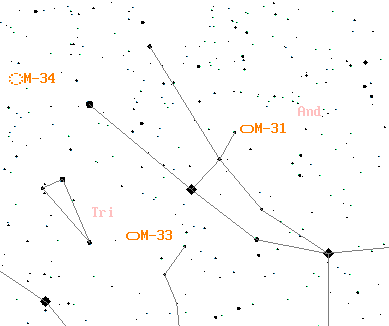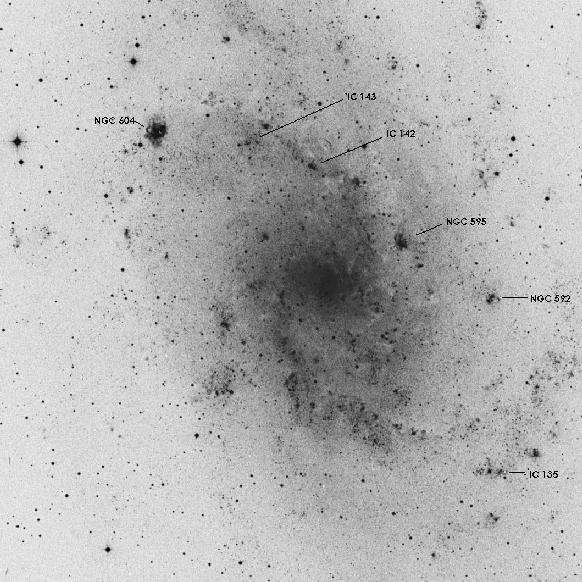M33 - Big and Faint
Jack Kramer
Think of an object that is vague, large, and difficult to see, and the spiral galaxy M33 in Triangulum surely comes to mind. It is one of those objects that absolutely requires a dark sky in order to be seen with any detail. If you are able to see it at all from your back yard, it appears as a faint smudge and nothing more. Go to where the sky is very dark and the detail you will see is amazing. Its neighbor both in our sky and in the Local Group, the Great Andromeda Galaxy (M31) is the largest and brightest object of its kind visible from northern skies, and while we can view some of its spiral structure, we see M31 at a rather oblique angle. On the other hand, M33 presents us with a somewhat more face-on view. It's also known as the "Pinwheel Galaxy", which hints at the aspect whereby we are able to really appreciate the sight of a huge and complicated spiral.
M33 is slightly farther from us than M31 and is a bit smaller in size. Although its visual magnitude is around 6.0, the large size and low surface brightness make it an elusive target in light polluted skies. But if you know where to look, it's not all that difficult to locate. I've seen it in finders as small as 6x30 from moderately dark sites. In the dark sky of New Mexico, it's a naked eye object.

Apart from contemplating the beauty of this galaxy, a worthwhile pursuit is to search out the bright HII regions in its spiral arms. These are clouds of ionized (electrically-charged) hydrogen that in effect are emission nebulae akin to the famous Orion Nebula (M42) that we enjoy close-up within our own galaxy. There are a large number of these HII regions in M33; the brightest have been identified as NGC or IC objects. The darker the sky and the larger your telescope, the more of these nebulae you will see. The first step is to take your time and simply scan the overall image with a very wide field eyepiece to locate the spiral structure. If your sky background is sufficiently dark, an eyepiece such as a 40mm or 32mm Erfle is ideal for the initial scan. Make sure your eyes are well dark-adapted. In the accompanying image from the Palomar Observatory Sky Survey, I've identified only a few of the brightest HII regions. (Understand that the word "brightest" is a relative term -- they're all extremely faint visually.) Not all the smudges you see in the image are HII regions -- many are merely concentrations of stars. The easiest way to begin your search is to start with the largest and brightest -- NGC 604. I found it helpful to verify the orientation of M33 by locating the two fairly bright stars that almost form a right triangle with NGC 604 at one apex. (You'll find them in the upper left-hand corner of the image here.) Since M33 covers about one degree in our sky, you will have to wander quite far from the brighter hub in order to find details in the outer arms. Having identified where NGC 604 is situated in the image of M33 as it appears in your scope, proceed "around the galaxy" until you pick up others.
Of the HII regions, I have seen NGC 604, 595, 592, and 588 using a 10-inch scope. The observing location when initially recorded was the Green River Conservation Area south of Dixon, Illinois, which is a fairly dark site. NGC 588 is not shown in the image here; it lies just off the right edge almost in line with 595 and 592 at roughly the same distance from 592 as 592 is from 595. None of these regions were easy targets. NGC 604 was the only one directly visible; the others were seen by averted vision. My records do not show a search for these regions from New Mexico, so that is definitely on the docket for the next trip down there. In addition, it might be worthwhile to try various nebula filters to see if they can somewhat enhance the view. These are, after all, emission nebulae that might become more apparent with the appropriate filter. On the other hand, because they're so faint, a filter might actually dim the HII regions, rather than pass enough light from the ionized hydrogen gas.
If you enjoy an observing challenge, this is one of the best!
M33 - Spiral Galaxy in Triangulum, showing the brighter HII regions
 Image from the Palomar Observatory Sky Survey
Image from the Palomar Observatory Sky Survey





